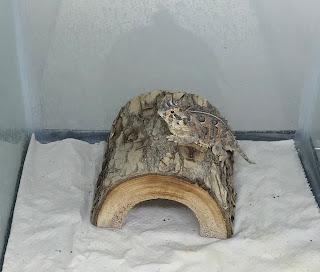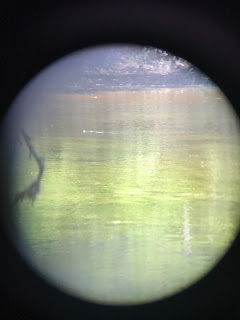One of the really fun observations in the summer of 2019 was seeing 3 different kinds of tiny (I'm talking less than an inch long) brown frogs and realizing they were different species based on the way that they moved!
The Rio Grande Chirping frog took long jumps (no video because it was in the grass):
The Narrowmouth toad juvenile (unsure if it is Western or Eastern) little hops with a small sit in between:
And the gulf coast toad (I think) juveniles alternated between hopping and bounding. Bounding is a behavior where they take consecutive hops on their toes and look a bit like they are running:
We even encountered a cottonmouth, which was not happy to see us. We kept a safe distance (photo is zoomed in), but it still "rattled" its tail in the water. I had no idea they would do that!
And this character once the pond dried out for the summer:
I also worked on a lab-based project with juvenile horned lizards and their anti-predator responses. Our experiments did not work very well though we worked out some of the kinks in the procedure by the end of summer. SO I will just share some adorable baby horned lizard pictures (plus a few adults) and call it a day. They were so sassy!
It was really cool watching them grow their horns <3
We also saw a cute little ground skink and a bright green treefrog (Hyla cinerea):
We even encountered a cottonmouth, which was not happy to see us. We kept a safe distance (photo is zoomed in), but it still "rattled" its tail in the water. I had no idea they would do that!
We saw plenty more water snakes with a range of personalities:
...and at long last found one juvenile ribbon snake!
And this character once the pond dried out for the summer:
I also worked on a lab-based project with juvenile horned lizards and their anti-predator responses. Our experiments did not work very well though we worked out some of the kinks in the procedure by the end of summer. SO I will just share some adorable baby horned lizard pictures (plus a few adults) and call it a day. They were so sassy!
It was really cool watching them grow their horns <3
In the summer of 2020, I did see a bunch of ribbon snakes but mostly from a distance. One pair seemed to be interacting with each other in the middle of the pond! Maybe some kind of courtship? (Hard to see but they are the two little heads poking up through the water).
I also unintentionally saved this toad, who continued to posture and show me their poison glands.
Managed to get a couple of pictures of these quick snakes! I do hope I get to work on them again one day!
In other exciting news, I moved to NC and started a tenure track position. I am not sure which or how much of these projects will continue, but it certainly started a new direction of questions to explore! I am excited to share new projects and updates with you all, as soon as I get myself organized. Exciting things ahead! So until then, stay safe and healthy.


























